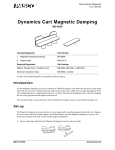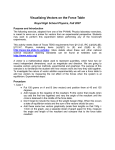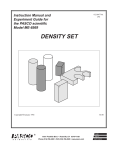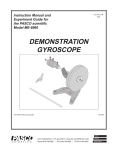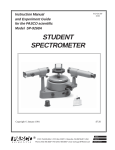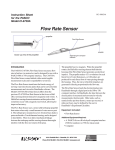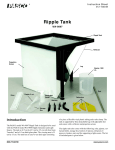Download PASCO Specialty & Mfg. ME-9866 User's Manual
Transcript
Instruction Manual Manual No. 012-08722 Demonstration Spring Set Model No. ME-9866 Model No. ME-9866 Warranty For a description of the product warranty, see the warranty description in the PASCO catalog. 2 ® Model No. ME-9866 Demonstration Spring Set Demonstration Spring Set Model No. ME-9866 Equipment List Included Equipment Replacement Part Number* 1. Four Demonstration Springs Spring constants: 4N/m to 14 N/m Lengths: 11 cm to 22 cm *Use Replacement Model Numbers to expedite replacement orders. Additional Equipment Recommended Hooked Mass Set SE-8759 Large Rod and Base ME-9355 Pendulum Clamp SE-9443 Physics String SE-8050 Meter Stick SE-8695 ® 3 Demonstration Spring Set Model No. ME-9866 Introduction PASCO's Demonstration Spring Set includes four large springs for use in demonstrations of Hooke's Law, static equilibrium and conservation of energy. Each spring is constructed of durable spring steel and includes convenient hooks at each end.Independence of X and Y Motion. Discovering Hooke’s Law 4 1. Hang the desired spring from a horizontal support and measure the distance from the bottom of the spring to the tabletop or floor. Record this distance in a data table. 2. Place a hooked mass or mass hanger on the bottom on the spring. ® Model No. ME-9866 3. Measure the distance from the bottom of the spring to the tabletop or floor. 4. Subtract the "initial distance" from the new distance to calculate the stretch of the spring. Record this value in a data table. 5. Place more mass on the spring and repeat measurements/ calculations. 6. Collect at least six pairs of hanging mass and stretch data. 7. Convert the hanging masses to force using the acceleration due to gravity: m 9.81 ----2s 8. Create a graph with force on the vertical axis and stretch on the horizontal axis. 9. Using y = mx + b, write an equation for each of the lines. Make sure to include appropriate variables, numbers, and units in the equation. Demonstration Spring Set 10. The slope of the Force vs. Stretch graph in known as the spring constant or rate. The vertical intercept represents the amount of force needed to begin stretching the spring and is also known as the initial tension. Conservation of Energy 1. Determine the spring constant of the strongest spring. ® 5 Demonstration Spring Set Model No. ME-9866 2. Hang the spring from horizontal support above a tabletop. 3. Tie a 30 cm piece of string to a 200 g mass. 4. Feed the string through the center of the spring and tie to the horizontal support such that the hook of the mass is around the bottom loop of the spring, but not stretching it. 5. Ask students to use conservation of energy to calculate how far the mass will fall when the string is cut. 6. The horizontal support should then be adjusted so the mass will just miss the tabletop when the string is cut. 7. Cut the string to test the students' hypothesis. 6 ®






